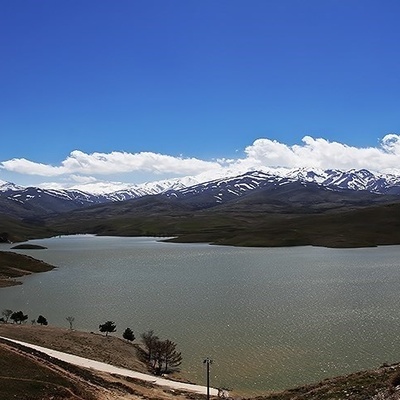Drive the dusty Alborz tracks to Tar Lake and you’ll find a blue alpine bowl where mountains, thyme and clear water make a perfect quick escape from the city.

Geological studies show that shifts in the central Alborz created two deep basins able to hold runoff, seasonal streams and spring overflows. Those two basins formed the neighbouring lakes known as Tar and Hooyr. This piece focuses on the larger of the two: Tar Lake.
When you stand by the lake, seasonal and precipitation changes affect the water level: depth can reach up to 50 metres, while the enclosing ridges tower roughly 500 metres above the lake. The lake’s maximum dimensions measure approximately 1 kilometre long by 400 metres wide.

Like many striking places, Tar Lake attracts local folklore. Some say the water is a remnant of ancient seas and that pirate treasure still lies on the bottom; others tell of strange creatures that emerge at night. Neither science, history nor visitor reports support these tales — Tar Lake is best appreciated as an exceptional natural feature.
If you’re on a guided tour, follow its instructions; for private travel, take the Firuzkuh road and, after Damavand, choose one of the minor routes toward Chenar Gharb, Oru or Delichai. After those villages you will face 20–30 km of dirt track that leads to the lakeshore.

The most pleasant months are in the first half of the year, especially late May through September, when mountain cooling keeps daytime highs around 18°C even in the hottest periods. If you welcome frozen surfaces, seasonal winds and you’re equipped for winter alpine conditions, the lake can be rewarding year-round.
Extensive grazing and poor land management have caused serious soil erosion. Although plant diversity exists, the overall cover has diminished; visitors are asked to avoid lighting fires because burning vegetation removes fragile soil and plant substrates needed for mountain flora to recover.
Wildlife is more encouraging. If you are fortunate, you may observe mountain sheep (male and female) and goats that descend to the shoreline to drink. Aquatic life includes rainbow trout and yellowfin-type fish, which keep the water lively.
Essential for a short picnic | Gear for overnight / multi-activity trips |
|---|---|
Thermos for tea, picnic mat, single meal | Tent, food supplies (can buy locally), hiking boots |
— | Warm and windproof clothing, blankets or sleeping bags |
— | Torch / lighting equipment |
— | Picnic utensils; charcoal or firewood (note: avoid fires when possible) |
— | Personal items (sunscreen, toiletries) |

Tar Lake offers a wide variety of activities. Off-road enthusiasts can enjoy rough-track driving and motorbiking — ensure your vehicle or bike is serviced before the dirt sections. Hikers will find gentle rolling terrain between the two lakes (Hooyr and Tar) suitable for walks; serious climbers can plan ascents of nearby peaks such as Qareh-Dagh and Zarrin-Kooh. Other typical activities include:
Swimming in warm months and seeing the frozen surface in winter.
Inflatable-boat paddling (bring your own small craft).
Fishing — only with an environmental permit.
Scented thyme meadows for relaxed nature walks.
Lakeside camping.
Landscape photography — from high viewpoints the view of Damavand and the basin is especially dramatic; at lakeside the sense of the mountains wrapping you in a valley is equally compelling.

On unpaved forks, ask locals for directions to avoid wrong turns.
Some locals may request a small entrance fee (usually modest).
If driving your own vehicle, ensure it is fully serviceable: the dirt route has steep passes, sharp bends and few roadside services. On weekdays the route is quiet; in case of emergency you may be alone.
If you plan to camp overnight, pitch close to ranger stations or in areas frequented by park staff — wildlife may approach the shoreline at night.
There is no dedicated managing authority for maintenance or waste removal; leave no trace.

Hooyr Lake — about 1 km away.
Hooyr village — roughly 10 km from the lake.
This short guide introduced Tar Lake near Damavand and summarized the main activities possible at the site. The text is not exhaustive — please share your experiences to help build a fuller local guide for future visitors.
Tip | Source (paraphrased) |
|---|---|
Ask local people for directions once you reach dirt tracks to avoid wrong forks. | “After entering dirt roads, ask locals for the address to avoid getting lost.” |
Ensure your vehicle is in good condition before the dirt sections; the route has steep passes and isolated stretches. | “If you drive, confirm your vehicle’s capability and health — the track has passes and cliffs.” |
If camping overnight, stay near ranger or park staff areas — wildlife often visits the shore at night. | “If staying overnight, camp near ranger stations because nocturnal animals approach the lake.” |
Bring complete camping gear and cold-weather clothing if you plan to stay overnight or visit in colder months. | (Packing checklist items: tent, warm clothes, sleeping bag, torch.) |
Carry out all trash — there’s no formal waste management at the site. | “There is no organisation in charge of cleanliness; leave no trace.” |

